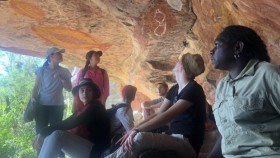From honey bees to bioengineering
by Stefan Bröer
In contrast to the human eye, which projects the environment through a lens onto the retina as an image, honey bees use a compound eye comprised of many ommatidia that capture small portions of the environment. Due to the size of the honey bee brain, these small visual fields are not computationally combined into a large image. Instead, edges are recognised and orientation is made possible by comparing the angles through which patterns appear in adjacent ommatidia, essentially measuring the parallax of optical patterns. This is supported by movements of the head allowing the bee to compute the arrangement of features in its environment.
The relatively simple neural circuits required to compute recognition of patterns by a moving field of ommatidia, allowed the visual science group at the Research School of Biology led by Adrian Horridge in collaboration with Levick Bishop at the John Curtin School of Medical Research and Alan Snyder of the Applied Mathematics Department at ANU to develop a small device in the shape of a thimble to detect simple patterns and to convert them into electrical outputs. This device was intended to help blind people recognise items in their immediate environment. However, at the time no interest could be raised in Australia to produce such a device commercially. After the Chernobyl disaster the Japanese Government was interested in the development of robots that could help with disaster recovery after a radioactive incident. After a world-wide search for suitable computational software the Visual Science Group at RSB was able to arrange a contract with Fujitsu to provide the necessary expertise for a value $10 million.
Word of the success of applying honey bee vision to engineering problems got around resulting in new applications. The US Navy became interested in using the technology to help landing helicopters on ships in rough seas. A daunting problems for pilots who could easily damage the landing gear of a helicopter if the ship moves upwards while the helicopter moves downward. Visual processing using honey bee inspired electronic circuits could solve the problem and was later also used to control landing approaches of remotely controlled space crafts.
This article is one of a set featuring the achievements and memorable occasions in the History of Biology at ANU.








